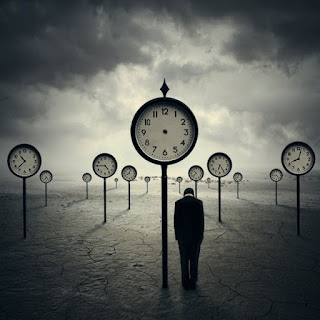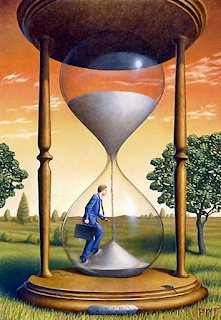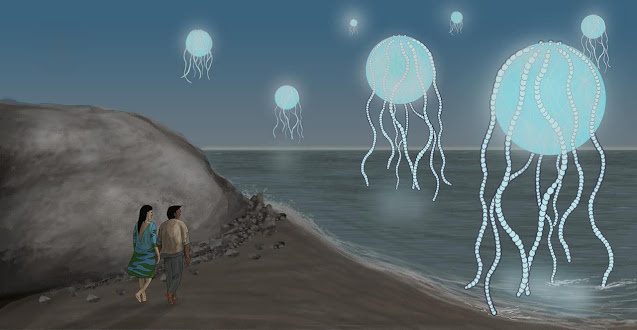Yes, Time is REAL ... strange!
"Time is an illusion."
Really?
"Time does not exist!"
Are you sure?
"Time is man-made."
Erm.... OK..... WHEN, exactly???
One question which has racked the brains of many curious people - from philosophers to physicists - is by its very nature an eternal one:
What is time?
The dictionary says: "the indefinite continued progress of existence and events in the past, present, and future regarded as a whole." but that only tells us so much. It tells us what time is like - to some extent - but it does not tell us what time actually is.
Whatever it is, time is a very fundamental element of reality, and that is part of the problem. We can define it in relation to other things - speed, distance, etc. - but those other things tend to be defined in relation to time, so the reasoning goes round in circles...
Ancient religions often saw time as being cyclic rather than linear; eternal rather than finite. The Sun, Moon and planets move in seeming perpetual motion, day following night and season following season in a continually repeating pattern. It was a reasonable conclusion that this would be the the way Nature is in its most fundamental ways.
Some traditions - some of the Greek philosophers such as Antiphon and Permenides, plus Buddhism and the Kabbalah - regard time as not being real, but as being an illusion.
Classical mechanics, from Isaac Newton onwards, saw time as an element of the universe that was absolute: a regular, unchanging phenomenon. Time moves in one direction only, at the same rate for everyone, everywhere. Time and space were both considered as a type of 'background' where events took place.
RELATIVITY
But even in those days it was clear that this was not quite the whole picture. In 1632 Galileo introduced an early concept of relativity. He used the example of a passenger below decks on a ship sailing smoothly, at a constant speed, across a calm ocean. The passenger will feel no sensation of movement so he will be unable to determine if he is moving or stationary.
From this it follows that motion and speed can only be defined in relative, not absolute terms. If you are walking along at about 1.4 metres per second this means that you are travelling through space at 1.4 metres per seond, correct?
Well, not quite. Beneath your feet is the planet Earth, which is revolving at around 460 metres per second (about one thousand miles an hour.) So you are actually moving at THAT speed, correct?
Well, not quite. The Earth is also orbiting the Sun at a pretty rapid thirty kilometres per second.... Plus, the whole solar system is moving with the rotation of the galaxy, about 600kmps. Plus the galaxy is moving....
But I'll stop there. The point is, motion and speed are always relative. You are walking at 1.4mps relative to the Earth. The Earth is rotating at 460mps relative to the Sun. And so on and so
on...
This is something a lot of people find difficult to understand: there is NO 'fixed' absolute reference point. Nowhere in the whole universe, because absolutely everything in the universe is moving in relation to something else.
There is no such thing as 'still'.
Just as the words 'slow' and 'fast' are meaningless without context, so are the actual units we use to measure velocity. It is all relative.
Given this, and given that speed, distance and time are fundamentally related, time itself begins to look less like an absolute quantity.
PERCEPTIONS AND MEASUREMENTS
This is true physically and also in our perception of time which is, of course, very different to its objective measurement. This is especially true in the case of placing oneslf within the systems of time based on the cycle of day and night: Noon for a person in London is not noon for a person in Tokyo. Hop on a plane flying west and you can visit yesterday...
For this reason the conventions of time zones and UTC (Co-ordinated Universal Time) were conceived. However, this only underlines the physical reality that, despite your location on the rotating Earth, time is nevertheless fundamentally the same for you as it is for someone on the other side of the globe. In this framework, space makes no difference to time because (Euclidean) space is WITHIN time...
Then there are there psychological elements that affect our perception of time. Unpleasant or unstimulating experiences may appear to last longer than ordinary experiences, whereas pleasant times seem to pass all too quickly ("tempus fugit: time flies"). During moments of great stress sensory awareness is heightened due to elevated hormones and neurotransmitters (the 'fight or flight' response of the sympathetic nervous system). This may have the effect where time seems to slow down.
Human memory is also notoriously unreliable; far from being the passive record of events that many assume it to be, our recollections are often influenced by many different factors and do not always match what really happened. This colours our percepton of time when recalling past events.
ENTROPY
The Laws of Thermodynamics showed nature to be absolutely strict regarding the flow (or 'Arrow') of time, particularly in the case of the Second Law: the total entropy of an isolated system can never decrease over time. Entropy (disorder) will always increase, this being a natural process that is not reversible. For example, a hot cup of coffee if left untouched will gradually cool until its temperature is balanced with that of its surroundings. Nature and time almost seem to desire a level balance of energy (equilibrium); the coffee never spontaneously heats up.
AETHER
Just as time was seen as an absolute constant, so was space. The Scottish physicist James Clerk Maxwell demonstrated with his equations that electromagnetic radiation (light) propagates through space in the form of waves. This raised the question: if light is a wave, what is waving? What is it a wave of?
Sound waves travel through air, what do light waves travel through when they cross the vacuum of space? The proposed medium was referred to as the luminiferous aether: a three-dimensional field that filled the whole universe.
In 1887 the Michelson–Morley experiment was an attempt to detect the existence of this aether. Specifically, it was looking for evidence of the aether being dragged by the Earth as it orbits the Sun. A rotating inferometer was used to split a beam of light in two and directing them down two paths at right angles to each other, then reflecting them back to recombine in an interference pattern at an eyepiece.
Assuming that the dragging of the aether would produce a 'wind', it was expected that the light beam that was travelling parallel to the wind would take longer to return because it would be travelling 'downwind' (like a fish swimming against the flow of a river, rather than with the flow). The interference pattern would show the degree to which the beam was being slowed down.
This became the most famous "failed" experiment in history when the results continued to show no difference in the time it took for the light beams to reach the eyepiece. Regardless of the position of the arms, both beams travelled at exactly the same speed. There was no drag effect caused by an aether wind, so there could be no aether. Light was travelling through nothing, as a wave of nothing!
This also verified Maxwell's equations which stated that the speed of light was an absolute constant, regardless of the observer's frame of reference.
This goes against classical Newtonian physics and against our 'natural' intuition. If you are standing still and you fire a gun the bullet will move at speed x. If you are standing on a moving train and fire your gun in the same direction that the train is moving, the speed of the bullet (relative to a stationary observer) will be x plus the speed of the train...
But if you are shining a torch instead of firing a gun, the speed of light is NOT increased by the motion of the train. It is measured to be exactly the same by both observers, the stationary one and the one in motion.
Physicists tried to work out how this could be the case. Perhaps the measuring apparatus itself was changing as it moved, maybe contracting in the direction of motion, and/or gaining mass? Hendrik Lorentz suggested that an effect of this type could account for the apparent constancy of the speed of light in different frames of reference. His equations (the Lorentz transformations) showed that time itself would appear to increase or decrease for different observers. This is called time dilation.
SPECIAL RELATIVITY
In 1905 Albert Einstein looked at all of this evidence and came to a different conclusion: the observed effects are not changes of the physical objects in question, but of space and time themselves. This was the beginning of his theory of special relativity (SR), in which space and time are regarded as one phenomenon - spacetime - which, far from being absolute and monolithic, is actually quite flexible.
For these considerations it is regarded as being a four-dimensional continuum consisting of three spatial dimensions and one time dimension, often called Minkowski spacetime after the mathematician Hermann Minkowski.
One of the consequences of the two principal postulates of SR - the invariance of the laws of physics in all inertial frames of reference and the constancy of the speed of light for observers in all frames of reference - was the conclusion that mass is equivalent to energy. This is famously expressed in the formula E = mc2 (energy equals mass multiplied by the speed of light in a vacuum squared).
THE FINITE SPEED OF LIGHT
Let's imagine a highly unlikely scenario. We send two spacecraft out, one to Mercury and one to the Sun. Both ships have on-board clocks perfectly synchronised with Greenwich Mean Time in London. The ships both travel at a normal speed, so there is no time dilation. When they arrive at their destinations their clocks are still synchronised.
The next day, at exactly midday, the Sun somehow vanishes.
What happens to us here on Earth? At that exact moment: nothing at all. You would still see sunlight shining on the trees. You could look up and see the sun, looking perfectly normal, just as it always has done. Why? Because it is eight light minutes away. That is the time it takes for light from the Sun to reach the Earth.
If you were the astronaut visiting Mercury (on the same side of the Sun as the Earth at that moment) , it would be exactly the same (just without the trees). At 12.04, however, it all goes dark. At the same moment, Mercury goes flying off into the outer reaches of the galaxy as the Sun's gravitational field blinks out of existence. (Gravity 'travels' at the same speed as light).
At 12:04 on Earth, though, still nothing has changed. We still see the Sun and, through our telescopes, Mercury orbiting the Sun normally. The same at 12:05, 12:06...... Not until 12:08 does darkness and chaos descend.
Hang on a second..... At 12:04 Mercury has gone flying off into the great unknown, maybe killing the astronaut in the process, but we can look through the telescope and see her walking around on the planet surface.
Is she dead or alive?
Well, I'm afraid that, in reality, she is dead. The light we see at 12:04 when we look at Mercury is four minutes old. We are seeing Mercury as it was at 12:00, when the Sun vanished but Mercury had still not got the memo....
TIME DILATION
Einstein later formulated general relativity (GR) which defined gravity as the curvature of spacetime, this curvature caused by the presence of mass. In both special and general relativity, spacetime displays its disconcerting flexibility...
To a non-accelerating observer, objects travelling close to the speed of light DO contract in the direction of motion. Time dilation is also a real, physical effect.
The traditional thought experiment regarding time dilation in special relativity is the so-called Twin Paradox:
Take a pair of twins, put one on a spacecraft travelling away from the Earth at a speed close to that of light. He reaches his destination and then returns to Earth at the same speed. When he meets up with his twin, he discovers that less time has passed for him, in his spacecraft, than has passed for his Earth-bound brother.
Travelling close to light speed means that time slows down for him in comparison to his brother (and everyone else on Earth). This means that his journey will seem to take less time for him, though it passes 'normally' on Earth.
For example, if he travels to Alpha Centauri (four light years away) at 99% of the speed of light, it will take him just over four years to get there, and just over eight years to make the return journey. When he returns to Earth his brother will be eight years older but, for the traveller, only one year has passed (14% of that time) on board his ship.
But is this real??? Yes, it is. It has been verified by experiments in particle accelerators, and we can see it in nature...
Cosmic rays (radiation from the sun, stars, supernovas, etc.) react with particles in the upper reaches of Earth's atmosphere producing subatomic particles called muons. A muon has a very short lifespan, 2.2 microseconds (2.2 millionths of a second). Having little mass, muons travel at close to the speed of light, and can be detected reaching the surface of the Earth.
At first this makes no sense because their 'half-life' is so short that - even at that great speed - they should decay before they travel the distance. The fact that they DO reach the Earth's surface is proof that time dilation is real. For the muon, travelling close to the speed of light, time passes more slowly compared to objects with mass moving at a 'normal' speed (such as the Earth).
This phenomenon has been summed up succinctly (if not quite comprehensively) as "The faster you move through space, the slower you move through time."
Time dilation also occurs in general relativity, this time in relation to gravity. Time passes more slowly in a strong gravitational field than it does in relation to a weaker one. How do we know this is true? It has been verified by very precise clocks. Those at a great altitude record time moving more slowly compared to those nearer the surface of the Earth.
This effect is also seen in the GPS satellite network, and for this reason the network has to make constant corrections in order to maintain accuracy. The difference is very small, but significant.
In a very real sense, your feet are younger than your head...
RELATIVITY OF SIMULTANEITY
The constant - but finite - speed of light has some serious implications for our intuitive understanding of space and time. It shakes our foundations in very startling ways, probably most keenly in the notion of the relativity of simultaneity.
Remember I said that everything is relative? Well that applies not only to the "speed" of time (how quickly it passes), it also applies to the order of time.
Put simply, two events that are observed by you to occur simultaneously may be observed by someone else to occur at different times....
Einstein devised this thought experiment: a person (A) is sitting in the centre of a train carriage as it moves through a station. As it passes the platform, a person standing there (B) sees lightning strike the front and the back of the carriage simultaneously.
Person B see light from each flash reach the passenger A simultaneously, because in both cases the light is travelling the same distance.
Passenger A also sees light from both flashes reach him simultaneously, of course.
So for both observers, the two lightning strikes occurred simultaneously, correct?
Actually, no. Because the train is moving, the passenger is moving towards the point at the front of the train where the lightning struck. He is catching up with that point in space, so light from that point has less distance to cover in order to reach him than the light from the back end.
Because the speed of light is finite and constant, it takes less time to cover a shorter distance (from the front towards the passenger). Therefore, light from the front of the train should reach the passenger before the light from the back of the train, which has to travel a longer distance to catch up with him......
But it doesn't!
Both flashes of light reach him at the same time, which means that light from the back (covering a longer distance) must have started travelling before the light from the front... Therefore, from the passenger's perspective, lightning struck the back of the train before it struck the front of the train.
But person B on the platform very clearly saw the two bolts of lightning strike simultaneously. So which person is right and which one is wrong?
This is the difficult bit: BOTH are right. In each person's frame of reference, they each take accuate measurements..... and come up with different results.
This shows us that, for two events occurring at different points in space, it is impossible to describe them as absolutely simultaneous. We can only say that they are simultaneous in a particular frame of reference. We cannot even say that one event absolutely precedes another.
It is all relative.
QUANTUM ENTANGLEMENT
OK, all of this is very perplexing and confusing, but "At least," you sigh "we can still agree on two sacred absolutes: nothing can travel faster than light and nothing, not even information, can move backwards through time!"
Right?
Right!?
Well...... Maybe.
As if relativity has not already messed with your head quite enough, along comes quantum mechanics to REALLY go to town on your braincells.
It certainly upset Albert Einstein!
QM predicted that if two subatomic particles were produced in such a state that their individual properties (such as polarisation of photons) cannot be described, they are 'entangled' (they exist as a system of two with one, uncertain state).
Once the property of one particle is measured this uncertainty collapses and the second particle, if measured, will show the corresponding property to the first one.
This effect occurs instantaneously.... even if the two particles are separated by a distance greater than that which it would take light to travel to transmit the information...
In 1935 Einstein called this "spooky action at a distance" because for information to travel faster than light violates causality (cause and effect)... and yet experiments in quantum entanglement verified it to be a very real phenomenon.
Once one particle was measured its twin somehow "knew" that it had to assume the corresponding property.
This is a huge problem. Information travelling faster than light is the same as information travelling backwards through time... which is impossible. Remember entropy? The Arrow of Time? The Second Law of Thermodynamics?
In 2015 physicist Justin Lee proposed that once a measurement is made, the quantum state of the two-particle system does indeed decohere (collapse) backwards through time. How can it do this without creating a paradox? Without violating cause and effect?
The solution is that the only thing that is changed in the past is the nature of the uncertain entangled state. Nothing else in the universe is affected at that time, so causality is not violated. It sounds like science fiction but it is allowed by our understanding of physical laws.
REAL...?
We rely on accurate time keeping for so many things, and it works very well in our ordinary lives, but out in space - travelling at 0.99c or skimming the event horizon of a black hole - it all gets a bit more complicated. Even here on Earth we cannot really say that two events happened at exactly the same time. And thanks to quantum entanglement we cannot even say that the Arrow of Time is sacred....
So is time - time itself - real? A real, physical thing that is really there?
Most definitely YES.
Without time, there is no space, because time and space are two inseparable aspects of one phenomenon, spacetime. And without space... Well, there would be nobody to ask the question.
However, it is much more complex than our intuitive understanding of it. We can almost forgive people for waxing philosophic and saying it is all an illusion.
Almost....
Time is real, but strange....REAL strange!














Comments
Post a Comment